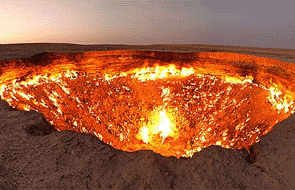
By Cameron Bagrie & Sharon Zollner*
 KEY POINTS
KEY POINTS
- The economy – and particularly the Canterbury region – is being supported by earthquake rebuild-related activity.
- There is a growing perception that the economy is then set to fall into a hole as the rebuild stimulus fades.
- We disagree.
− The stimulus peak from the rebuild is just under 2% of GDP, but this has been steadily building over four years and the stimulus will fade gradually from its forecast peak in 2017. We suspect the rebuild will take longer, but irrespective, people know it will peak in the coming years and this gives them time to adjust and plan accordingly.
− Christchurch rebuild stimulus is currently being offset by contractionary fiscal policy. Fiscal policy will not remain contractionary indefinitely; politicians won’t keep their hands off the loot.
− The scaling up in irrigation-related development across the Canterbury Plains will also provide a boost for the region.
− A host of the Canterbury rebuild-related work is necessary for replacement demand impetus to occur: tourism, education and CBD activity being examples. As the city “recovers” (is rebuilt), activity in these areas should too.
− The rebuild is placing pressure on aggregate demand; the unemployment rate in Canterbury is 2.8%. Some fading in momentum is to be expected given supply-side constraints. Fading momentum is not a downturn.
− Christchurch is chewing up resources that could otherwise be devoted to other activities. It’s natural for resources to be drawn to a major event. These resources can be redeployed ex-post.
− Various automatic stabilisers will adjust as appropriate. As excess demand-related activity from the rebuild fades, so too will (some) pressure on the OCR (and indirectly on the NZD).
- Within this aggregate story, there will be regional-specific aspects to manage. Waning rebuild activity is Christchurch-specific; less contractionary fiscal policy is a national phenomenon. Resources will therefore need to adjust. The onus is on local policy-makers and businesses to get alternate drivers of growth into place in a timely fashion.
- For Christchurch to flourish post the rebuild, key microeconomic facets and sectors need to be firing. The likes of the education sector, manufacturing, agriculture, tourism (think the airport versus Queenstown and Auckland), and the port (we note some major competition pending out of Timaru) need to be performing well.
Identifying and unlocking the alternate drivers of growth beyond the rebuild need to be front and centre, and we can see that on some levels. It’ll be a failure to drive broader regional activity that will determine the post-rebuild bog (or not), and not waning rebuild activity itself.
--------------------------------------------
The Christchurch rebuild effort is providing a large stimulus to the New Zealand economy.
Unfortunately we do not have a measure of exrebuild GDP, but various statistics show clear evidence of an impact. Concrete production for Canterbury has nearly trebled since early 2011, as opposed to a 15% gain elsewhere. Increases in Canterbury employment have outstripped those in the rest of the country by a factor of close to 2, with the Canterbury region adding 38,000 jobs in the last year, providing nearly half of the nationwide increase.
Canterbury residential building consent numbers were up more than 40% compared to the previous June year, with Canterbury accounting for around one quarter of the value of construction work in the March 2014 year. Our Regional Trends measure of economic activity has growth in the Canterbury region up 4.7% y/y, tied for top spot across the country. This followed growth of 5.7% in the year to June 2013 and 7.2% the year prior to that. Technically that’s already a slowdown, but from an exorbitant pace.
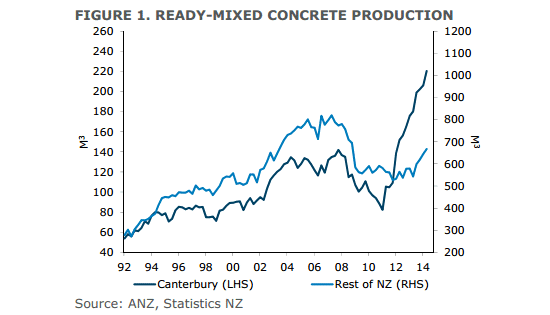
Given the sheer scale and complexity of the $40bn rebuild, it is likely to have long-lasting impacts. As such, it is difficult to know with exact certainty how long the rebuild will take and what the resource cost will be. Taking RBNZ estimates as a guideline, the likelihood is that the rebuild will peak at around 2% of GDP in around 2017. But in terms of GDP growth and the battle for resources, it is the pick-up (change) in the rebuild spend each year that matters. The growth stimulus in terms of the incremental boost to growth is likely to be peaking about now, and will likely wane from this year.
Assuming rebuild activity peaks in 2017, the growth impetus will turn negative from 2018. So is the New Zealand economy going to fall into a deep hole when the stimulus from the rebuild wanes? Simply eyeballing Figure 2 dents that story. The pick-up – incremental change between years – has been gradual, and the easing back in activity will be likewise. The spill-overs from higher construction sector activity will take time to boost other sectors and diffuse through the wider economy.
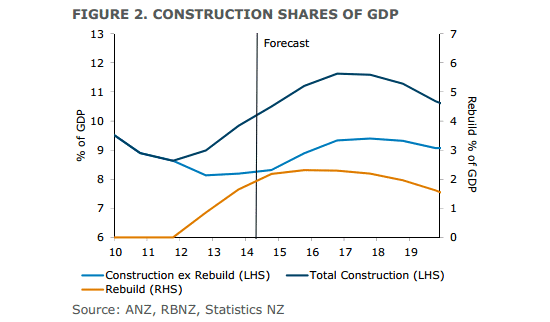
There are also a number of broader reasons why we think that the New Zealand economy will cope just fine when the Christchurch rebuild stimulus tapers off.
1. As the rebuild fades so too will the negative impact of contractionary fiscal policy.
Christchurch stimulus is currently being offset by fiscal austerity; the fiscal stance has been negative since 2010/11, and the stance is projected to be negative to the tune of 2.4% of GDP over the next four years. That’s a major headwind to the economy. Netting off the two, the net impact on aggregate demand has been negligible – though there are clear regional winners and losers.
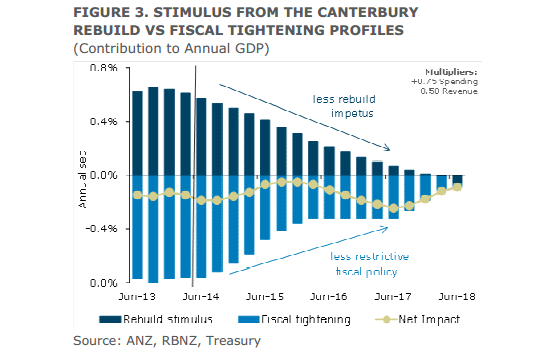
Moreover, as rebuild stimulus fades, so too will the impact of contractionary fiscal policy, according to (smoothed) Treasury fiscal forecasts. The fiscal stance is still projected to be tight, but less restrictive than it has been. With fiscal surpluses within reach and net debt under control there is a temptation for the politicians to raid the lolly jar. We’ve already seen the provision for further initiatives in upcoming Budgets raised from $1 to $1.5 billion and tax cuts are being mooted.
2. The implications of the scaling up in irrigation-related development across the Canterbury Plains are not broadly acknowledged.
It’s huge, including North Canterbury and right down to North Otago. That’s a pending boom for Christchurch.
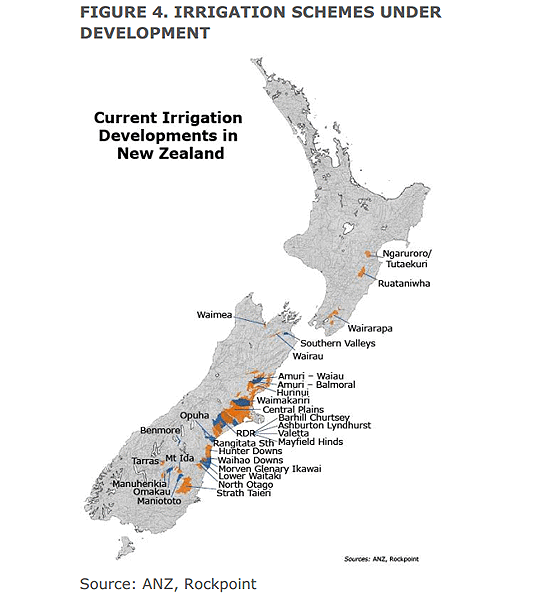
3. The ramping up in rebuild activity has been gradual; so too will be the waning on the other side.
And it is being well flagged, giving people time to adjust. Indeed, the rebuild in all likelihood won’t be “finished” in our lifetimes, such was the scope of the destruction. A gradual decline means lower odds of a nasty correction in the local housing market as construction workers return to their usual homes. But the local housing market will feel the change in the wind, no question.
4. A host of the Canterbury rebuild-related work is necessary for replacement demand impetus to occur: tourism, education and CBD activity being examples.
We’ve seen immediate recovery in some sectors. The retail sector has bounced back. Since 2010 retail spending has risen 25% versus a 13.6% rise in the rest of the country. Large swathes of Christchurch’s industrial heart were able to carry on with relatively little disruption after the quakes.
This has been a massive positive for the region. Port volumes did fall over 2011 but quickly bounced back. Import volumes have grown very strongly as capital equipment and materials for the rebuild have been imported. Compared with 2010, exports out of the port in 2013 were 46% higher, and imports were 38% higher. However, the picture across a host of other sectors remains subdued. Tourism inflows to Christchurch have lifted well off their lows but they remain low nonetheless. The number of guest nights in Christchurch is 73% of the level prior to the earthquakes, and the average international tourist spend is 65% of the preearthquake level.
Of course a quake-ravaged city is not exactly a tourism mecca, but there was also a lack of capacity with the large hotels out of action. This is evidenced by the lift in guest nights in the rest of Canterbury during this period. As more hotels open and the city recovers, guest nights will continue to rise. Enrolments at the University of Canterbury (at around 13,000 students in 2014) were approximately 30% lower than back in 2010.
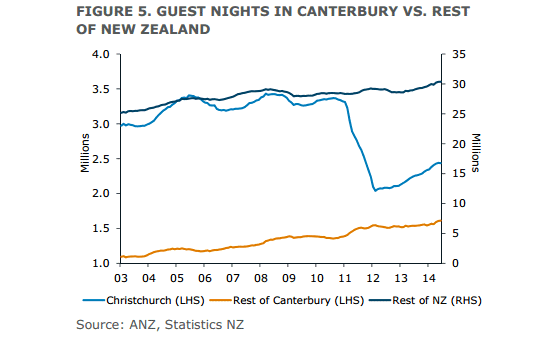
The critical point to note is that these sectors are infrastructure dependent. Get the infrastructure in place, increase the amenities available, build the housing, and the people will come.
5. Some fading in momentum is to be expected given supply-side constraints. The unemployment rate in Canterbury is 2.8% versus 5.6% nationwide.
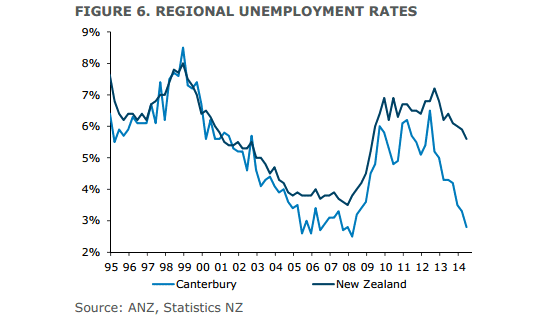
By ANZ estimates, the “output gap” (growth in activity versus the sustainable rate) is more positive in Canterbury than it is anywhere else in the country.
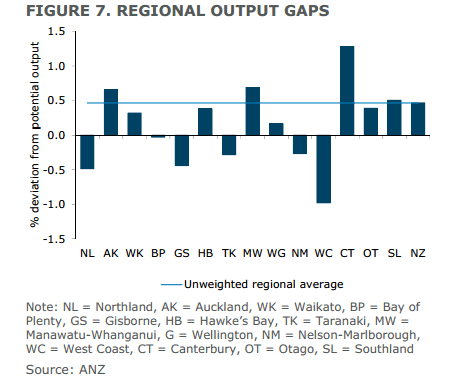
Such resource and capacity pressures are a natural bottleneck for growth. Activity grows at a less express pace when resource pressures mount – witness the decline in growth from 6%+ to sub-5% over the past couple of years. The important point here is that fading momentum – a solid but less spectacular rate of growth – is not a downturn. A downturn is when demand fades; managing supply side capacity to keep up with demand is a different dynamic.
6. Christchurch is chewing up resources that could be devoted to other activities.
It’s natural for resources to be drawn to a major event; and let’s face it, Christchurch is strategically important for the South Island so the Government’s cheque-book is also being thrown at it. These resources can be redeployed ex post; there is no shortage of construction demand across the economy (witness the implicit timing of the substitution between Christchurch and the rest of the country in figure 2).
Indeed, the building effort going on in Christchurch is going head to head with growing demand for construction around the country more generally.
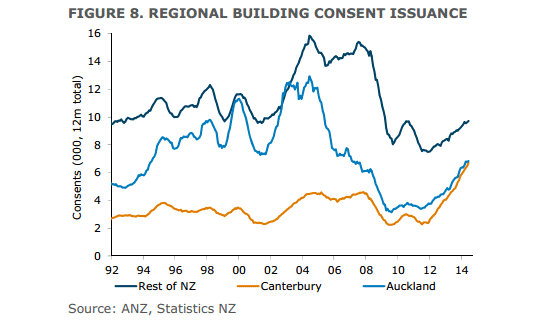
Auckland has immense housing demands to satisfy and the Government has earmarked significant funds for capital investment in the wider economy.
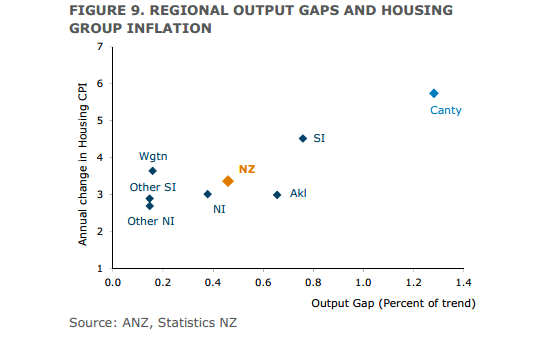
The rebuild effort is also showing up in inflation. This is hardly surprising – in a free-market economy prices are the mechanism by which resources are allocated. Construction wages need to be higher in Canterbury to draw in the skills required. Anecdotal evidence from around the South Island and beyond suggests the pull from the Christchurch rebuild has made tradespeople scarce elsewhere. The fact that the rebuild effort has been inflationary brings us to our final point.
7. Various automatic stabilisers will adjust as appropriate. As excess demand-related activity from the rebuild fades, so too will (some) pressure on the OCR (and indirectly on the NZD). Potential inflationary spill-overs from the rebuild has the RBNZ on notice; the inflation risks are clear. We’ve haven’t seen the follow-through – a pleasing dynamic.
The OCR has still headed up but not by a huge amount, and not in a hurry. Looking forward, as the stimulus from rebuild activity fades so too should pressure from construction cost-related inflation and some of the risks to general inflation. The key point here is that if rebuild stimulus was a factor driving more restrictive policy, the fading in stimulus should also have the same counterbalancing effect. The economy is a complex, interrelated system, where one factor impacts on others in varying ways over time. You can’t look at one variable in isolation given the inter-linkages at play.
The rebuild effort has been too large for the economy to simply digest and carry on with business as usual elsewhere. Activity elsewhere will be positively impacted from the easing of the rebuild stimulus, just as some activity was crowded out by Christchurch’s demand for resources. The upshot: simply subtracting the current rebuild stimulus from one’s growth forecasts is far too simplistic, just as adding it on to a baseline forecast a few years ago would have been.
Finally
Though the waning of the rebuild effort does not spell doom and gloom for the wider NZ economy, there will, however, clearly be regional specific aspects to manage. Waning rebuild activity is Christchurch-specific; it will leave a void in the local construction arena. Less contractionary fiscal policy is a national phenomenon. The onus is on local policy-makers (and businesses) to get alternate drivers of growth in place in a timely fashion, and think more broadly beyond the rebuild itself.
There will be frictions internally as the key drivers of growth in Christchurch swivel away from construction towards broader sectors, including tourism. That’s natural. Resources will need to adjust too; there will be tension as this process pans out. For Christchurch to flourish post the rebuild, key microeconomic facets and sectors need to be firing. This includes the education sector (two universities or potentially an amalgamated one), manufacturing (a hub of non-commodity manufacturing excellence), agriculture (Canterbury Plains-related development), emerging IT businesses, tourism (think Christchurch airport versus Queenstown and Auckland competing for tourism inflows), and the port (we note some major competition pending out of Timaru).
There have been some encouraging developments. New direct air routes between Christchurch Airport and Taiwan are an example of a small microeconomic facet that will add progressive impetus to growth and backbone beyond the rebuild. It is success (or failure) in these areas that will determine whether the post-2017 peak in the rebuild turns into a real bog. The story is far broader than simply looking at what the eventual fading in rebuild stimulus alone means for the region.
--------------------------------------------------
* Cameron Bagrie is ANZ's chief economist and Sharon Zöllner an ANZ senior economist.
3 Comments
NEWS September 2021: Just 10 short years after the rebuilding from the Christchurch quakes injected billions into the national economy, the finishing touches are put to the final rebuild project.
NEWS OCTOBER 2021: The Alpine fault lets rip causing devastation to all of the South Island............
We welcome your comments below. If you are not already registered, please register to comment.
Remember we welcome robust, respectful and insightful debate. We don't welcome abusive or defamatory comments and will de-register those repeatedly making such comments. Our current comment policy is here.